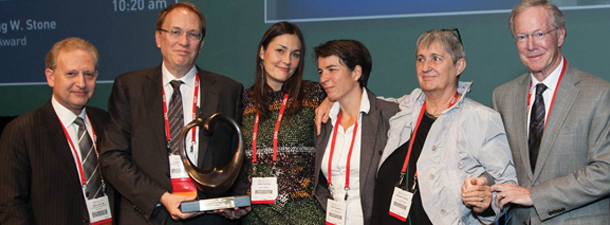Featured News
- Innovate
- Investigate
- Educate

CRF was delighted to have Gruentzig’s family and close associates from the early years of his career present at TCT to share in this special tribute.
The Cardiovascular Research Foundation presented Andreas Gruentzig, MD, the TCT Career Achievement Award posthumously on Tuesday, October 29, in recognition of his contribution to the development of the field of interventional cardiology.
More than 35 years ago, Dr. Gruentzig, now considered by many to be the father of interventional cardiology, performed the first balloon angioplasty of a coronary artery in Zurich, Switzerland. The procedure began a revolution in the field of cardiology, offering patients an alternative to bypass surgery and opening the door to percutaneous cardiovascular procedures including transcatheter treatment of valvular disease, hypertension and heart failure, and prevention of stroke.
Gruentzig, 46, and his wife Margaret Anne, died in a plane crash in Georgia in October 1985. CRF was delighted to have his family and close associates from the early years of his career present at TCT to share in this special tribute.
“Without Dr. Gruentzig’s singular vision and determination, our subspecialty would not exist, and tens of millions of patients would not have benefited from the lesser invasive approach to coronary artery disease that is angioplasty,” said TCT director Gregg W. Stone, MD. Gruentzig had the “charisma and force of personality to stand up to doubters and persist in the face of adversity, promoting a technique that he knew in his soul could help so many,” Stone said.
Gruentzig earned his medical degree in Heidelberg, Germany, in 1964 and began training in angiology. Soon after, he took an interest in techniques pioneered by vascular radiologist Charles Dotter, MD, for opening vessels in the legs using catheters. Gruentzig learned these techniques from his mentor, Eberhard Zeitler, MD, in Nuremberg, Germany.
With his interest piqued, Gruentzig began using catheters in practice but knew that in order to apply the technique to coronary arteries, a new type of device would be required. The device would have to be small enough to enter the arteries, but also would have to be able to enlarge once it was placed inside the obstruction.
Spencer B. King III, MD, of Saint Joseph’s Medical Group in Atlanta, Ga., said Dr. Gruentzig hit upon the idea of a balloon that would expand inside the artery. Working in his kitchen with colleagues, he began to experiment with materials, focused on the idea that the balloon would have to be rigid to force open the lesion.
The double lumen catheter with a polyvinyl chloride balloon they developed was tried first in leg arteries and then kidney arteries, and was finally miniaturized enough for use in coronary arteries.
In 1976, Gruentzig presented the results of his animal studies involving his new device in a poster at the American Heart Association (AHA) Scientific Sessions. In the studies, a silk ligature was used as a constrictor in the canine coronary artery dilation. The balloon was expanded to break the thread and restore flow.
Although Dr. King admitted to being skeptical of the idea, the experiment caught the eye of other physicians at the meeting, including Richard Myler, MD, who would eventually invite Gruentzig to perform angioplasty on one of his sedated surgical patients in San Francisco.
Not long after in September 1977, Dr. Gruentzig performed the first coronary angioplasty on an unanesthetized patient in Zurich.
In 1977, Gruentzig was invited back to the AHA Scientific Sessions to make an oral presentation about his animal experiments. Instead, he presented his first four human angioplasty cases including one very dramatic procedure of a left main stenosis.
“The reaction from the audience was astonishment,” King said. “He received a standing ovation.”
As interest in learning the technique increased, Gruentzig began to televise courses from Zurich where he would demonstrate the procedure to colleagues eager to learn.
“There was a lot of collegiality at that time,” said King. “People who had done 10 procedures were experts at the time and they interacted with people who were just starting out with it.”
Gruentzig had a drive and determination to educate and share his knowledge with the world, but he also was concerned that the procedure not be misused.
According to Stone, Gruentzig symbolized the characteristics that exemplify current interventional cardiology including a thoughtful and evidence-based approach to procedures that always puts the patient’s interests and outcomes first.
In January 1980, Gruentzig moved to the United States where he joined the faculty, including King, at Emory University in Atlanta. During the next few years, he worked with others to develop the technique. By 1984, trials comparing angioplasty with bypass surgery were initiated. Unfortunately, Gruentzig did not live to see the amazing results of those studies.
If he was alive today, he would be tremendously proud of this whole specialty that he started, which has gone from a kitchen table to a specialty that has grown worldwide.”
- Spencer B. King III, MD
“Interventional procedures not only have become the dominant procedures for coronary interventions, but also are dramatically outpacing surgery and have, more importantly, become the primary procedure for acute MI and have opened the flood gates to structural heart interventions and more,” said King.